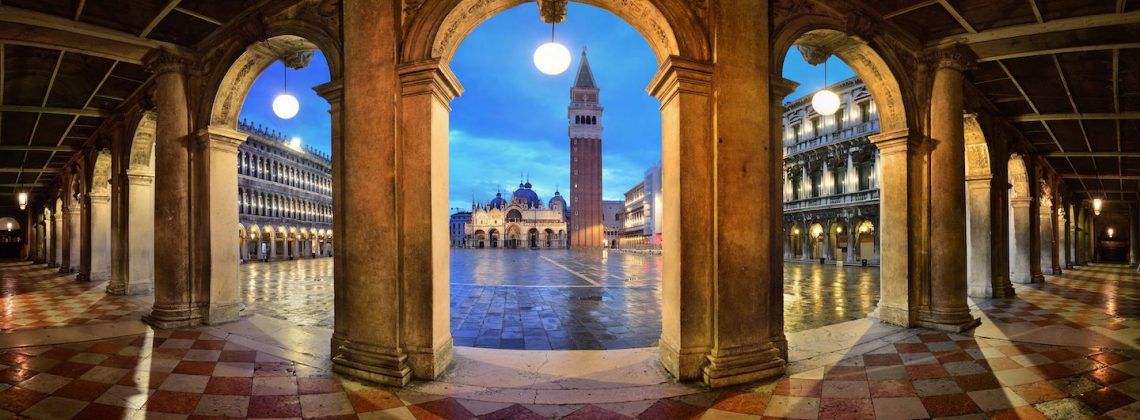We think of Venice for its canals, bridges, and narrow winding alleyways. But did you know this city once ruled a Mediterranean empire? Or that its government inspired the USA’s Founding Fathers? Learn more about Venice’s history from a historian of Italy and the Mediterranean!
This article isn’t meant to replace a guided visit – quite the opposite! Reading up on an attraction will make a guided tour more memorable and interesting! You will impress your travel partners and engage more with the guide. Check out our guided tours in Venice.
A Short History of an Iconic Italian City with Global Connections
They say all roads lead to Rome. Well, the Romans must have missed this marshy corner of the Adriatic where we find the island city of Venice. In fact, as historian John Foot explains, Venice is unique among major Italian cities (not just for its geography) but also because it did not exist in the Roman Empire’s heyday.
However, as we’ll see, Roman refugees fleeing troubles in the Western Roman Empire founded Venice. Furthermore, as scholar Thomas F. Madden tells us, the city did owe allegiance in its early years to the Eastern Roman or Byzantine Empire. Moreover, from there the city spread its wings (or unfurled its sails to be more exact) to dominate Mediterranean trade routes for centuries.
In fact, by the 12th century, Venice emerged as one of Europe’s leading powers. For example, as historian David Abulafia points out, the city boasted extensive commercial networks, a rather unique aristocratic republic style of government, a flourishing Renaissance-era cultural scene, and a powerful military. Thus, all these factors enabled Venice to be known as “La Serenissima” (“The Most Serene”).
Although never a large territorial empire like Ancient Rome, Venice ruled colonial possessions across the Adriatic and the eastern Mediterranean for centuries. As a result, even though we think of Venice as one city in Italy, we’ll find it has a much wider Mediterranean imprint. So, let’s hop in our imaginary boat and explore the canals and history of Venice!
421 AD-1082 AD
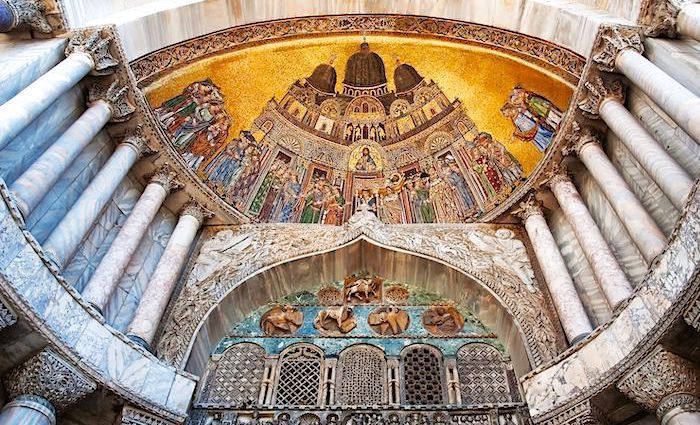
Myths | Refuge | New Identity
Historian Elizabeth Horodowich says Venice’s origin is a collision of history and myth. What we do know is that Venice’s first inhabitants fled troubles brewing within the collapsing Western Roman Empire. Moreover, Horodowich explains that the most famous myth is Venice was founded by Roman consuls from Padua (exactly at noon) on March 25, 421 AD. Ever the enterprising businesspeople, the Venetians even claim their city’s founding had a precise appointment time.
Gradually as historian Roberto Cessi explains, early inhabitants asserted some authority, electing the first Doge or Duke, named Orso (Ursus) in 727. However, by 751 we find Venice as a remote outpost of the Byzantine Empire.
Moreover, historian Thomas F. Madden says by the early 800s the Byzantine governor of the area moved to the protected island of Rialto within the boundaries of present-day Venice. A big boost for the city came in 810-814 when Charlemagne and the Franks failed to seize Venice after a costly siege.
Moreover, Venice’s prestige grew in 828. In that year enterprising Venetian merchants retrieved the relics of St. Mark the Evangelist from the Egyptian city of Alexandria. At the same time, historian Thomas F. Madden says, a major church office moved to Venice, securing even greater autonomy for the city. What is more, historian Ed Muir says St. Mark became Venice’s symbol, depicted through the winged lion.
1082-1297 AD
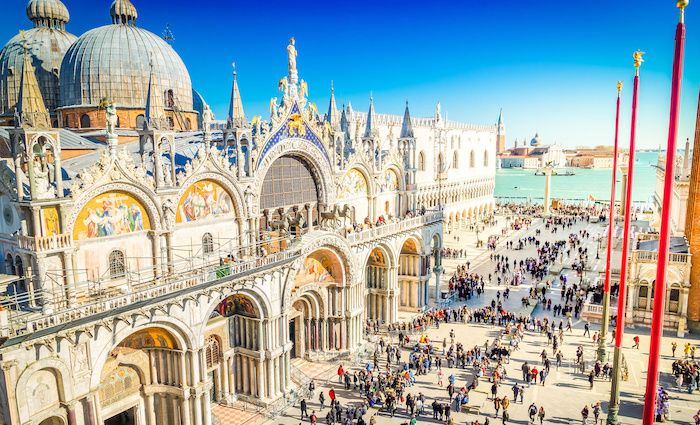
Growth | Crusades | Marco Polo
Venice’s inhabitants had by now become true products of both the lagoon where the city’s interconnected islands sit and the Adriatic Sea. Bolstered by valuable trade privileges granted by the Byzantine emperor in 1082, Venetian merchants embarked on expanding trade routes. In time, historian Elizabeth Horodowich tells us, Venice dominated the vital salt trade.
However, by the late 1170s, historian Roberto Cessi says Venetian-Byzantine relations soured. In fact, the emperor encouraged Venice’s rivals like Genoa to trade in Byzantine markets. While relations temporarily improved, Venetians remained bitter towards the Byzantine Empire.
As historian Roberto Cessi explains, the Venetians took their revenge during the Fourth Crusade in 1204. Crusaders pillaged Constantinople and drove the Byzantines out of the city for over five decades. As a result, St. Mark’s Basilica became a sort of trophy case for Venice. It displayed loot from pillaged Constantinople, including the famous bronze horses. Moreover, as historian Ed Muir explains, it marked Venice’s rising power and break with declining Byzantium.
Moreover, the late 13th century is when that famous Venetian merchant, Marco Polo enters the story. Historian Joanne Ferraro says Marco joined his father and uncle’s trading business in Asia in 1269. Marco then traveled extensively through Asia, returning to Venice in 1295. Ferraro says Marco’s extensive travel notes allowed Europeans to learn much about cultures, commodities, and technologies.
1297-1499 AD
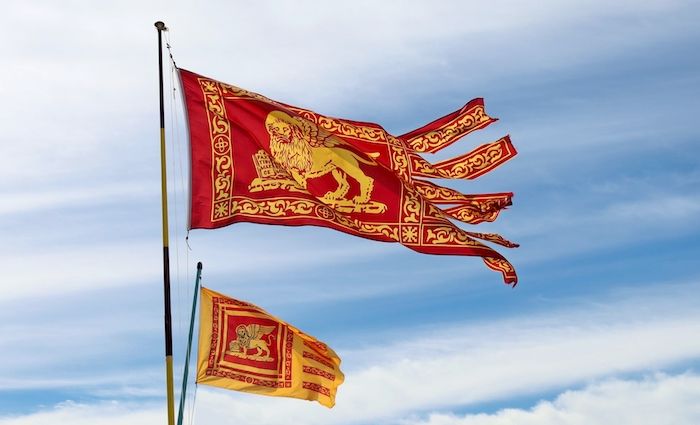
Republic Founded | Expansion | Zenith
Indeed, historian John Jeffries Martin says that the year 1297 is the traditional date scholars give to the foundation of the Venetian Republic. However, Venice’s style of republic is not exactly like what you’d find a few centuries later in the United States or France. As historian Elizabeth Horodowich explains, the republic was dominated by aristocrats who essentially elected a sovereign (still called the Doge or Duke).
Moreover, as historian Christopher Friedrichs tells us, nowhere in urban Europe had a more exclusive clique of aristocratic families as Venice. In fact, according to Friedrichs, no families were added to the nobility’s ranks between 1381 and 1646. Nevertheless, the example of a European republic amidst a crowd of mostly absolute monarchies still served as one inspiration for the Founding Fathers in the United States.
Yet the Venetian Republic’s commercial superiority faced serious challenges during the Age of Exploration. Indeed, not just Venice, but the entire Mediterranean region ultimately receded from the international stage for the period’s growing imperial powers like Spain and France.
By the late 15th century, Venice had expanded its territorial holdings across the Adriatic. Over the next four centuries, the Venetian Republic conquered many ports in the eastern Mediterranean. However, as scholar David Brewer explains, Venetian expansion brought the city into conflict with one of the period’s most powerful states: the Ottoman Empire.
1500-1632 AD
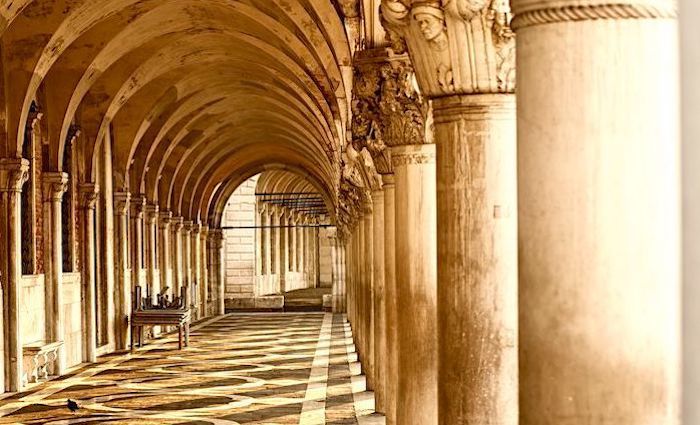
Ottoman Wars & Trade | Architectural Wonders | Art & Politics
But the Venetians did not shy away from the mighty Ottoman Empire. Nor as historian E. Nathalie Rothman tells us, did Venice just fight the Ottomans. In fact, Rothman continues, Venetian and Ottoman merchants maintained major commercial networks despite decades of intermittent conflict. And all that trading got Venetian merchants very rich.
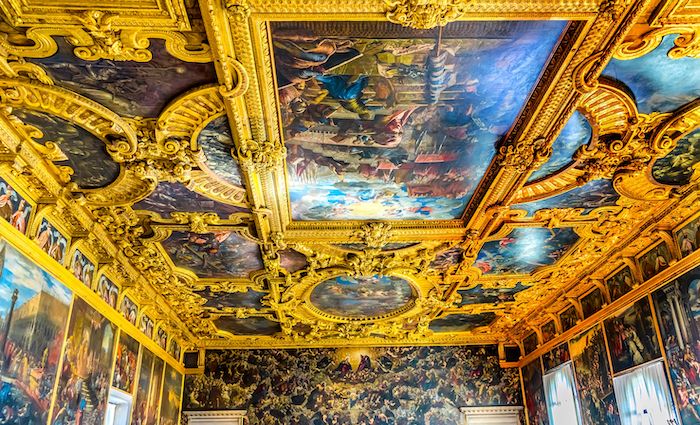
Moreover, historian Ed Muir explains Venetian wealth translated into lavish displays of the city’s commercial and military prowess. A quick tour of many of Venice’s most famous landmarks reveals such displays during the Venetian Republic’s zenith. Take for instance the Doge’s Palace.
Initially built between the 1340s and 1420s, but later extended, the Doge’s Palace still crowns Venice’s St. Mark’s Square. According to historian Dennis Romano, the Doge’s Place is a blend of influences from across the Mediterranean world. Moreover, many rooms received quite the sprucing up during the days of the Venetian Renaissance. In fact, today you’ll see art from the likes of celebrated Venetian artists like Tintoretto.
Furthermore, Tintoretto’s art for the Doge’s Palace gives us a great example of the intermixing of art and politics. For example, Tintoretto’s massive oil painting Paradise (1588-1592) adorns the room where Venice’s noble senators once shaped the city’s fate. Scholars like art historian Tom Nichols say the painting meant to remind Venice’s aristocratic leaders of the heavenly rewards for good governance in Venetian domains.
1633-1700 AD
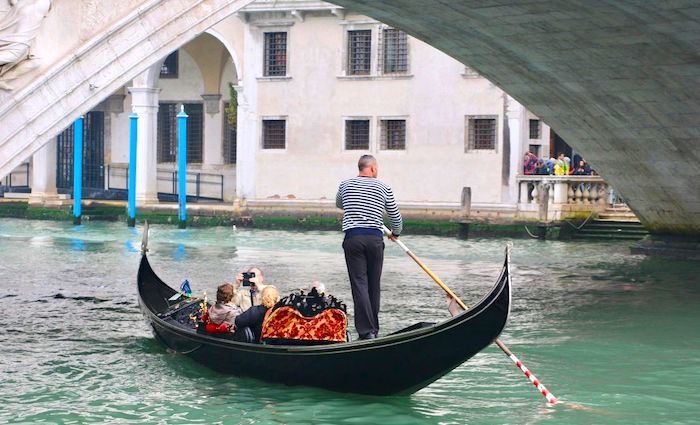
Decline | Grand Tourists | Gondolas
As the Venetians and Ottomans slugged it out in multiple wars, they bled their respective treasuries and militaries dry. As a result, both sides experienced expensive financial and material losses. Moreover, scholar David Brewer points out Venice and the Ottomans constantly swapped territories particularly in present-day Greece.
Fortunately for the Venetians, they found yet another way to make money: tourism. In fact, you could say Venice is where tourism as we know it all started. For example, many scholars as historian Eric G.E. Zuelow says consider the Grand Tour to be the origin of modern tourism. Wealthy northern Europeans fell in love with Venice’s now-iconic cityscape.
Ever the enterprising businesspeople, Venetians set about making sure these Grand Tourists had priceless memories of their city. As art historian Xavier F. Salomon explains, Venetian artist Canaletto become so beloved among English Grand Tourists for his paintings of Venice that he briefly moved to England to be nearer his market.
One iconic symbol of Venice hasn’t entered our story: gondolas. Think gondolas are a recent addition to Venice? In fact, anthropologist Meredith Small says gondolas first appeared on the lagoon and around Venice’s canals as early as the 11th century! Indeed, these legendary flat-bottomed rowboats so characteristic of Venice came under scrutiny in the 16th and 17th centuries. Small explains that in 1562 and 1633, Venetian administrators required that all gondolas be painted black. In this way, Small continues, people couldn’t flaunt their wealth on the city’s waterways.
1700-1866 AD

Republic Ends | Revolutionary Turmoil | Italian Unification
However, the French Revolutionary Wars at the close of the 18th century disrupted Grand Tour routes to Italy. Yet, Venice faced far worse challenges than the temporary decrease in foreign visitors. In fact, as historian John Jeffries Martin explains, war meant the Venetian Republic itself was in danger. Indeed, in May 1797 a twentysomething French general named Napoleon Bonaparte decided the Venetian Republic should be history.
Napoleon and the French did not just end the Venetian Republic and seize the city. French troops looted and Napoleon himself made sure many art treasures were secured for France. For example, as historian R.J.B. Bosworth notes, the famous Bronze Horses of St. Mark’s Basilica were shipped to Paris. (Today both the originals and copies are on display in Venice).
Napoleon also produced sweeping changes in Venice and across Italy. For instance, as historian Andrew Roberts explains, he redrew borders and created new French satellite states including the Kingdom of Italy. Moreover, historian Alexander Grab says Napoleon swept away existing orders, including the longstanding provision (since the 16th century) that Venice’s Jewish population remain in the Jewish Ghetto.
French rule though gave way to Austrian by 1815. However, revolutionary fervor in 1840s Europe swept into Venice through the person of Daniele Manin. As a result, historian Jonathan Sperber points out that revolutionaries briefly declared another republic in Venice. Although crushed by the Austrians, rebellious sentiment remained through the cause of Italian Unification.
1866-Present
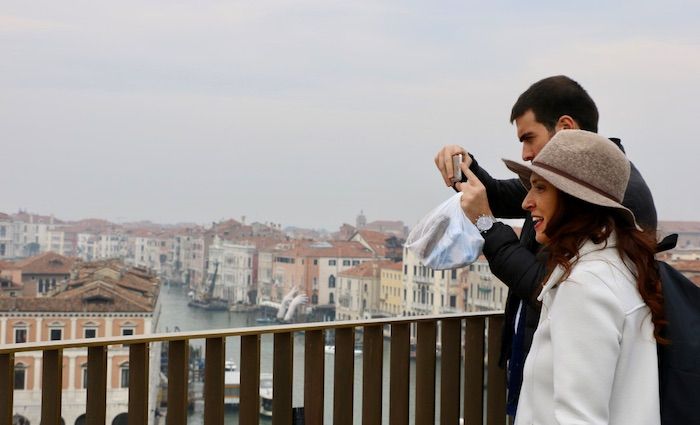
Modernization | New Enterprises | Legacies
In Venice’s case, historian Chris Duggan tells us unification with Italy came in 1866. In that year, Prussian statesman Otto von Bismarck bullied Austria into ceding Venice to Italy. A new state meant new rulers and modernization initiatives for Venice.
What is more, prominent Venetian entrepreneurs like Count Giuseppe Volpi and Vittorio Cini brought electricity to Venice and a host of business opportunities. For example, historian R.J.B. Bosworth says they founded a luxury hotel group. Moreover, Bosworth continues, Volpi founded the famous Venice Film Festival in the early 1930s.
By that point, as Bosworth explains, Volpi had already been a leading figure in Mussolini’s Fascist regime. As the 1930s continued, the regime’s foreign policy pushed Italy on a collision course for war. After the war, Venice returned to welcoming international tourists.
Indeed, Venice boasts a rich legacy scattered across the globe. For instance, historian Ed Muir explains the US Founding Fathers drew inspiration from Venice and other republics when framing the nascent United States government. Furthermore, the name of Venetian merchant Marco Polo is famous the world over. Finally, you’ll find symbols of Venice like the Lion of St. Mark across the Adriatic and the eastern Mediterranean.
And now you’re ready to explore Venice! Check out our guided tours in Venice.
